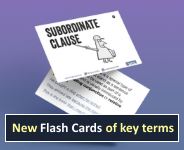Pronouns
Pronouns are one of the eight word classes in the National Curriculum. Some linguists would treat pronouns as a subclass of nouns, and there are some good reasons for that, but we adhere to the National Currciulum specifications.
Pronouns can sometimes replace a noun in a sentence:
Welcome back!

Englicious is totally free for everyone to use!
But you will have to log in to see our library of teaching resources.
If you don’t have an account, that’s perfectly OK. You can register (for free).
It only takes a minute or two.
»
- Printer-friendly version
- Log in to view or leave comments

